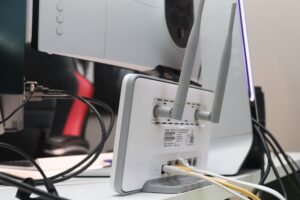
Solving WiFi Performance Problems: A Non-Technical Guide with AI-Powered WiFi Assurance

Your organization can’t run without reliable, optimal WiFi performance. Every employee depends on it, as does every site visitor. If you want to communicate, sell products and services, design, teach, and grow, you need a strong, protected WiFi network.
The reality is though, these networks are under constant “attack.” Now, we don’t mean cyberattacks (although these are a real threat), but rather the attack from internal and external factors that cause poor WiFi performance. Without the proper notification and mitigation methods, these “smaller” attacks can derail WiFi performance, operational efficiency, and user experience, costing organizations hundreds of thousands of dollars.
Let’s take a look at some common WiFi performance problems and how to resolve them.
Contents
What causes poor WiFi performance?
Outdated Hardware and Firmware
Symptoms of poor WiFi performance
How do I fix my WiFi performance?
Outdated Hardware and Firmware Solutions
Preventing performance issues with AI-powered WiFi assurance
Benefits of using AI-powered WiFi assurance solutions
How to implement AI-powered WiFi assurance
What causes poor WiFi performance?
Poor WiFi performance can be caused by signal interference, network congestion, outdated hardware and firmware, and suboptimal access point (AP) placement.
Signal Interference
It’s normal for signal strength to rise and fall throughout the day depending on a user’s location and the type of building construction. However, these changes should never disrupt user experience. If users are reporting issues, that’s a problem.
Signal interference can be caused by both WiFi and non-WiFi factors.
- WiFi factors
- Co-channel interference from your own network
- Unauthorized APs
- Printers
- Non-WiFi factors
- Bluetooth
- Microwave ovens
- Refrigerators
- Transmission lines
- Generators
- Power plants
- Radar
Network Congestion
A congested network is similar to a highway suffering from a traffic jam: data might be moving, but it’s crawling rather than flying. If you want to know why your WiFi channels are congested, a few culprits include:
- A high number of connected devices
- Co-channel interference (CCI)
- Adjacent channel interference (ACI)
- Many devices performing data-intensive tasks such as video streaming and conferencing
- Extremely large file downloads and uploads
- Hotspots or other unauthorized APs
- Non-WiFi factors like Bluetooth, microwaves, radios, and cordless phones
Outdated Hardware and Firmware
Hardware refers to the physical pieces of a network, such as user devices, routers, APs, and servers.
Firmware is the software that provides basic instructions to your hardware so that it can function.
If your firmware is out of date, you might be missing out on the latest bug patches and security fixes. This can lead to poor WiFi performance. Similarly, if your hardware is out of date, it might not be able to provide the performance (such as high speeds) that you need.
Suboptimal AP placement
WiFi devices communicate by sending data packets through the air.. These packets can be slowed down or blocked by physical objects such as walls and furniture. Concrete and metal are especially likely to block WiFi signals.
For this reason, if APs aren’t placed in the best possible locations, WiFi performance can suffer as the data packets struggle to make it from one device to another.
Symptoms of poor WiFi performance
There are many performance issues that can plague a WiFi network. They include:
- Slow internet speeds
- Unreliable connections
- High latency and ping times
- Buffering during streaming
- Disconnections and dropouts
With these issues, users will experience:
- Delays sending and receiving emails
- Delays loading websites
- Issues running VoIP and video applications
How do I fix my WiFi performance?
In order to resolve WiFi performance issues, you first must know the root cause of the problem. Once you have that crucial information, you can try one of the following:
Signal Interference Solutions
Depending on what’s causing the signal interference, you may need to:
- Relocate APs
- Identify and disconnect unauthorized APs
- Change the channel selection on some APs to avoid signal/transmission overlap.
Network Congestion Solutions
If this is your problem, consider:
- Creating different networks for different users: this allows you to prioritize employees and limit the bandwidth available to visitors. It also keeps a network more secure.
- Purchase more APs: if your network is growing, you may need more APs. Study your network in-depth before making this decision and be sure it’s the right solution. Too many APs can also cause WiFi performance problems.
- Review channel selection and make any necessary changes: if APs are too close together, they can experience adjacent channel interference and co-channel interference. Review all broadcast channels and make changes to avoid channel overlap. This may require you to relocate certain APs.
- Use Quality of Service (QoS) controls to prioritize specific applications.
Outdated Hardware and Firmware Solutions
In this instance, the solution is obvious:
- Update firmware
- Purchase new hardware
It’s common practice to upgrade or update hardware every 3-5 years. Be sure to budget for this and be prepared in case you need to make a purchase earlier than anticipated.
AP Placement Solutions
If you’ve identified suboptimal AP location as the cause of your issues, it’s time to move the AP. Before you do this, perform a site survey to identify all areas of interference and pick the best location for the AP. These surveys may need to be repeated every time office layout changes or new neighbors move in (if you operate in a shared building).
Preventing performance issues with AI-powered WiFi assurance
As you can see, resolving and preventing performance issues isn’t a simple task. Root cause identification alone can take IT hours or even days depending on the complexity of the issue and whether or not it is intermittent. Then, even once the root cause is nailed down, there can be a number of different resolutions. Trial and error are not words anyone wants to hear when business productivity is depending on you.
This is why many organizations adopt AI-powered WiFi assurance solutions. These solutions automate the identification, notification, and solution identification of WiFi issues. By working proactively, 24/7, these solutions provide assurance that the WiFi is optimized and is going to stay that way.
Benefits of using AI-powered WiFi assurance solutions
Organizations that use these solutions report:
Solutions monitor the entire network ecosystem in real-time, proactively identifying problems as soon as they occur – and sometimes, identifying potential issues before they occur. This complete visibility means that IT has assurance that the network is performing optimally unless they are otherwise notified.
- Improved user experience
Solutions that identify root causes automatically give IT everything they need to immediately resolve issues. These faster resolutions mean issues are often resolved before users are ever affected. This keeps UX high and dissatisfaction low.
- Less money spent on travel to remote sites
WiFi assurance solutions provide remote troubleshooting capabilities so that IT professionals can solve problems from any location at any time. This reduces the need to travel to remote sites, which not only saves organizations money but also means problems can be resolved faster.
- Boosted operational efficiency and productivity
Solutions not only identify issues in real-time, but also store historical data. This allows decision makers to see long-term trends in WiFi network behavior and performance. These trends might alert professionals that the network is nearing its max capacity, that certain APs are degrading, that certain applications show more issues than others, or that network utilization is evolving and different hardware might be required in the future. With these insights, budget-friendly updates can be made proactively, future-proofing the network.
How to implement AI-powered WiFi assurance
If you want to adopt an AI-powered WiFi assurance solution, follow these steps:
- Talk to IT professionals and other decision makers to find out what would make their lives easier. What network issues are they experiencing? Are there unsolved or repeat problems?
- Research solutions and find the one that best meets your needs. In addition to the capabilities included in the solution, be sure to ask:
- How will the solution integrate with existing network infrastructure?
- What if network infrastructure changes? Will the solution still work?
- How long does it take the solution to start delivering analytics and insights?
- How much training is required to use the solution?
- Review any testimonials and case studies.
- Ask the vendor for a demo and see if they offer a trial.
Wyebot’s Wireless Intelligence Platform™ is vendor-agnostic, AI-powered, and used by organizations around the world. We deliver:
- 90% faster resolutions
- 70% fewer WiFi problems
- 80% fewer remote site visits
Talk to us today and see how we can put an end to your WiFi performance problems.


